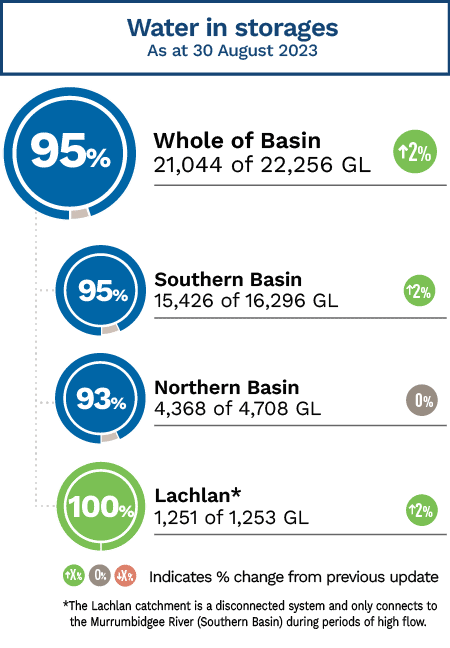- Lower rainfall in the Basin from July to August
- Dry conditions are forecast as we move through spring
- Water quality conditions are generally good, however there is still a risk of blue green algae in many waterways

Drought
The rainfall deciles for the previous 6-month period shows that most of the northern Basin experienced average to below average rainfall, with some areas recording very much below average rainfall. The southern Basin saw average to below average rainfall over the same period, with a large area of the Lower Darling recording above average rainfall.
August was Australia’s tenth-driest August on record, which led to most areas of the Basin that were already experiencing rainfall deficiencies to expand and become more severe.
Looking forward, most of Australia is at least 2.5 times as likely to experience unusually high maximum temperatures and below median rainfall from September to November.
This trend is reflected in root zone soil moisture levels over the year to date, which show a progressive reduction compared to 2022.

Rainfall
Across the Basin, area-averaged rainfall totalled 14.9 mm. This is 62% below the long-term August average recorded across most of the Basin. Areas of the northern Basin, including parts of the Condamine–Balonne and Warrego catchments recorded no rainfall for the month of August.
For the third month running, highest rainfall across the month was registered in alpine regions of Victoria in the upper reaches of the Ovens and Goulburn catchments. Mount Baw Baw received over 123 mm, setting the high benchmark for the month.

Storages and streamflow
As we enter Spring, cold conditions and low demand continue to keep storage levels across the Murray–Darling Basin fairly static.
At 30 August total storage in the Basin was 21,044 GL (95%), which is a slight increase from last month. Southern Basin storages rose by 2%, while the northern Basin remained steady and the Lachlan total storage increased by 2%, reaching full capacity.
Unregulated conditions have ceased along the River Murray from downstream of Hume Dam to Barmah. Downstream of Barmah to the South Australian border remains unregulated, and unregulated flows from Barmah to Torrumbarry are expected to cease shortly
Airspace management releases continue at Hume Dam to help manage flood risk into Spring. Releases are around 10,000 ML/d and may change subject to rainfall conditions.
Water regulators through the Barmah–Millewa Forest remain open to accommodate higher upstream flows.
On the Darling (Baaka), flows remain regulated with water being released from Menindee Lakes on behalf of environmental water holders to help improve fish and water quality downstream of Main Weir.
Flow to South Australia is forecast to reduce steeply over the coming weeks as flows upstream recede. Barrages are continuing to pass unregulated flows through to the Coorong and Murray Mouth.
Climate outlook
The Bureau’s long-range forecast into spring predicts below-median rainfall and above median maximum temperatures for most of Australia, including much of the Basin.
Climate influences on the spring long-range forecast include the possibility of an El Niño forming. Together with a positive Indian Ocean Dipole event likely to form during spring, this increases the chances of below average rainfall for the southern Basin.
There’s an increased risk of bushfires this spring for NSW, Victoria, Queensland, South Australia.

Water quality
Basin rivers and storages are nutrient rich and conditions remain favourable for blue green algae outbreaks. In the Lower Darling (Baaka) there is still a risk of low dissolved oxygen levels as floodwaters recede.
The Murray–Darling Basin Authority and state authorities monitor water quality conditions across the Basin year-round. For more information on water quality see the water quality page.
Summary of key water quality issues:
- Hypoxic blackwater: There are no current risks from hypoxic blackwater across the Basin.
- Low dissolved oxygen: Across the Basin, dissolved oxygen levels remain above critical ecological thresholds.
- Blue-green algae: There is currently a risk of blue-green algae across most parts of the Murray–Darling Basin, particularly in New South Wales. For the latest information on blue-green algae alerts, contact the relevant state government contacts via the Getting information about current algal blooms page of our website.
You can find all the latest news in our Newsroom or by following our socials: Facebook, X (Twitter), LinkedIn.